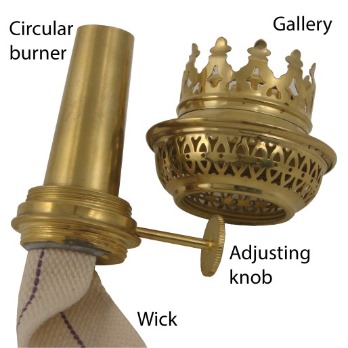




Burners
Our oil lamps are supplied with three types of burners.
The “rope” burner is the simplest one and employs a small circular wick, like a candlewick (and isn’t adjustable like the Perkeo burner). The flat burner employs a flat wick and so yields a much greater amount of light.
The circular burner uses a wide flat wick kept in a tubular shape. It yields the greatest amount of light by far.
An oil lamp with a 14’’’ circular burner consumes around 40g of lamp oil per hour, equivalent to 53ml per hour. This corresponds to an energy consumption of 508 watts. This energy is transformed to 102 watts of radiant heat, 405 watts to convection heat and only 1,26 watts are transformed to light! Only 0,25% of the input energy is converted to light. The oil lamp is therefore also a great heater!
A circular burners oil consumption and luminous intensity:
8 | ||||
9 | ||||
The quantities are approximate and based on given data of a 14’’’ circular burner in “Das moderne Beleuchtungswesen” from 1914.
The size of a circular burner is still expressed in “lines”.
1 foot = 1’ (= 12 inches)
1 inch = 1’’ (= 12 lines)
1 line = 1’’’ (= 2,1 mm).
Candela is the unit for light intensity. Originally candela was defined as the light intensity from a small candle. In Germany they used a Hefnerkerze which gave 11% more light.
1 candela = 1 cp (candle power).
1 candela = 0,9 HK (Hefnerkerze).
Lamp oil, kerosene or paraffin (oil)? We recommend odorless kerosene, this will give you an odorless combustion and make your wick last longer. Most important, make sure it’s a pure mineral oil.
Odorless kerosene density: 0,75.

Safety distance
Minimum distance from top of chimney to ceiling: Minimum 600 mm. Preferably 800 mm.
Use a smoke bell if this cannot be achieved.
Changing the wick in a circular burner:
Don't use the adjustment knob when removing the old wick from the burner!
If your wick has become stiff unscrew the burner so you can pull the wick out of the burner from below.
In this way you don't strain the wick adjusting mechanism.
The new wick is inserted from the bottom; curve the wick and push it into the curved slot.
Push until it reaches the cogwheels and you are able to, by turning the adjustment knob, to pass the wick through the burner tube to the top.
Trim the wick at the top so it's even all the way round.
Remember to let the wick soak for at least 3 hours before you light it!
Lighting you oil lamp the first time:
Fill the oil lamp container following the enclosed instructions. Trim the wick at the top so it's even all the way round.
Remember to let the wick soak for at least 3 hours before you light it!
If you have lit the lamp too early and burnt the wick edge, cut the burnt part away and let it soak until next Day. That should do the job!
Removing lacquer from an old oil lamp or any brass piece
At the time when honoured M. Jensen chandlers in Aarhus existed, they recommended Nitro Mors paint and varnish remover. A customer has added following advise: After application, wrap the item in Vita Wrap or similar and leave it for the next day. The lacquer is then completely dissolved and can fairly easily be removed.
Delite ApS
Lyfa-parken
Måløv Byvej 229E
DK-2760 Måløv
Phone: (+45) 77 34 78 90
© Copyright 2025 Delite